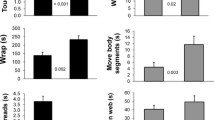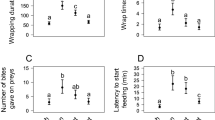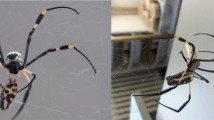Summary
The maximum body length of the phasmid Carausius morosus which the ctenid spider Cupiennius salei can overwhelm is 2–3x larger than the length of crickets. Eight phasmid species were offered to Cupiennius salei in feeding tests. Among them, Carausius morosus was raised on 4 different food plants. All species of prey items were accepted by the spider predator very readily (>80%). This indicates that phasmids are a highly palatable prey group for spiders. The possible importance of chemical defence and its obvious lack under laboratory conditions are discussed.
Similar content being viewed by others
References
Abrahamson WG (1988) Plant-animal interactions. MCGraw-Hill, New York
Bedford GO (1978) Biology and ecology of the Phasmatodea. Ann Rev Entomol 23:125–149
Blum MS (1981) Chemical defences of arthropods. New York, Academic Press
Carlberg U (1986) Phasmida: A biological review (Insecta). Zool Anz 216:1–18
Carlberg U (1887) Culturing stick- and leaf-insects (Phasmida)—A review. Z Versuchstierkd 29:39–63
Carlberg U (1990) Defensive stridulation in Heteropteryx dilatata Parkinson (Insecta: Phasmida). Zool Anz (in press)
Cassidy MD (1978) Development of a induced food plant preference in the Indian stick insect, Carausius morosus. Ent Exp Appl 24:87–93
Eisner T (1965) Defensive spray of a phasmid insect. Science 148:966–968
Emden HF (1972) Insect/plant relationship. Oxford, Blackwall
Nentwig W (1985) Prey analysis of four species of tropical orbweaving spiders (Araneae: Araneidae) and a comparison with araneids of the temperate zone. Oecologia 66:580–594
Nentwig W (1986) Non-webbuilding spiders: prey specialists or generalists? Oecologia 69:571–576
Nentwig W, Wissel C (1986) A comparison of prey lengths among spiders. Oecologia 68:595–600
Robinson MH, Lubin YD (1979) Specialists and generalists: The ecology and behavior of some web-building spiders from Papua New Guinea. Pacific Insects 21:133–164
Robinson MH, Robinson B (1973) Ecology and behavior of the giant wood spider Nephila maculata (Fabricius) in New Guinea. Smiths Contr Zool 149:1–76
Sivinski J (1980) The effects of mating on predation in the stick insect Diapheromera veliei Walsh (Phasmatodea: Heteronemiidae). Ann Entomol Soc Am 73:553–556
Author information
Authors and Affiliations
Rights and permissions
About this article
Cite this article
Nentwig, W. Stick insects (Phasmida) as prey of spiders: size, palatability and defence mechanisms in feeding tests. Oecologia 82, 446–449 (1990). https://doi.org/10.1007/BF00319784
Accepted:
Issue Date:
DOI: https://doi.org/10.1007/BF00319784




